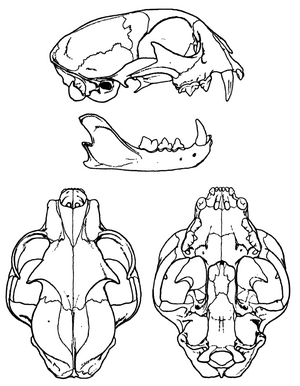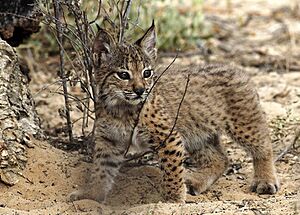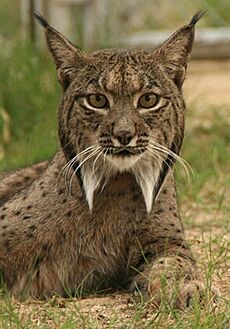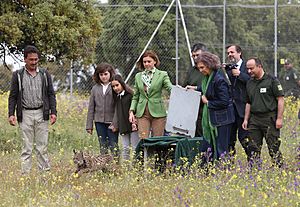Iberian lynx facts for kids
Quick facts for kids Iberian lynx |
|
|---|---|
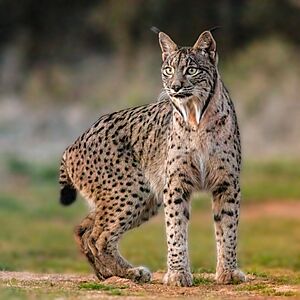 |
|
| Conservation status | |
| Scientific classification | |
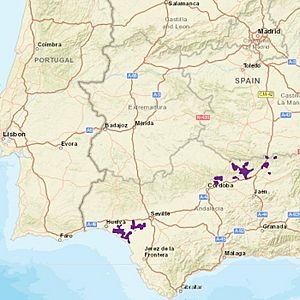 |
|
| Distribution of Iberian lynx, 2015 |
The Iberian lynx (Lynx pardinus) is a special type of wild cat. It is one of four kinds of lynx still alive today. This medium-sized cat lives only in the Iberian Peninsula in southwestern Europe.
For a long time, the Iberian lynx was in great danger. Its population dropped because of too much hunting and poaching. Their homes were also broken up, and their main food, the European rabbit, became sick.
By the early 2000s, there were only 94 Iberian lynxes left. They were almost gone! But people worked hard to save them. They improved the lynx's homes and helped the rabbit population grow. They also moved and released lynxes into new areas.
Thanks to these efforts, the number of lynxes grew a lot. In 2024, there were over 2,000 Iberian lynxes. Because of this success, their conservation status improved. They are now listed as "vulnerable," which means they are still at risk but doing much better.
Contents
What is the Iberian Lynx?
The Iberian lynx is a unique species of cat. Scientists believe it developed from an older type of lynx called Lynx issiodorensis. The oldest known fossils of the Iberian lynx are about one million years old. This shows they have lived in the region for a very long time.
The Iberian lynx is most closely related to the Eurasian lynx. Both types of lynx lived in the same areas until the 1900s.
What Does the Iberian Lynx Look Like?
The Iberian lynx has a short, yellowish-brown fur with dark spots. These spots can be small and round or longer in shape. They are often arranged in lines along its back and sides.
This lynx has a small head with tufts of fur on its ears. It also has a ruff, which is a collar of fur around its face. Its body is short, but it has long legs and a short tail.
Male lynxes are usually bigger than females. Males are about 75 to 82 centimeters (29 to 32 inches) long, not including their tail. They weigh between 7 and 16 kilograms (15 to 35 pounds). Females are a bit smaller, about 68 to 78 centimeters (27 to 31 inches) long. They weigh around 9 to 10 kilograms (20 to 22 pounds).
Where Do Iberian Lynxes Live?
Long ago, Iberian lynxes lived all over the Iberian Peninsula. This includes Spain and Portugal. In the 1950s, they were found from the Mediterranean Sea up to northern Portugal.
But their numbers dropped a lot. By the 1990s, they were only found in two small areas in southern Spain. They lost about 80% of their original home range by the year 2000.
Today, thanks to conservation efforts, their range is growing again. They are found in parts of southern Spain and Portugal. They like places with open grasslands mixed with dense bushes and trees. These trees include strawberry trees, mastic trees, and holm oaks. They also live in mountainous areas.
How Do Iberian Lynxes Behave?
Iberian lynxes mark their areas using their urine and by scratching tree bark. They also leave their scat (poop) to show where they have been. Adult lynxes usually stay in the same home range for many years.
Female lynxes have smaller home ranges than males. Females might use an area of about 5 to 7 square kilometers (2 to 2.7 square miles). Males need more space, with home ranges of about 12 square kilometers (4.6 square miles).
What Do Iberian Lynxes Eat?
The Iberian lynx mostly eats European rabbits. Rabbits make up most of their diet. They also eat other animals like red-legged partridges and small rodents. Sometimes, they will hunt young fallow deer or ducks.
A male lynx needs to eat about one rabbit each day. A female lynx with kittens needs much more food. She might eat three rabbits a day to feed herself and her young.
Lynxes are very picky eaters. Even when rabbit numbers dropped due to diseases, they still mostly ate rabbits. This made it harder for them to find enough food.
Iberian lynxes compete for food with other animals. These include the Iberian wolf, red fox, and Egyptian mongoose. Sometimes, a lynx will even hunt and kill these smaller meat-eating animals.
Iberian Lynx Life Cycle
Iberian lynx kittens start to become independent when they are 7 to 10 months old. But they usually stay with their mother until they are about 20 months old. How well the young lynxes survive depends a lot on how much food is available.
In the wild, both male and female lynxes can have babies when they are one year old. However, they usually wait until they can find their own territory. One female lynx did not have babies until she was five years old, after her mother died. Iberian lynxes can live up to 13 years in the wild.
It can be hard for lynxes to find mates. This has led to more inbreeding (mating with close relatives). Inbreeding can cause fewer kittens to be born and more young lynxes to die.
What Threats Do Iberian Lynxes Face?
The Iberian lynx faces several dangers. These include losing their habitat, being hit by cars, and illegal hunting.
- Habitat Loss: Their homes are being destroyed or broken up. This happens because of new roads, buildings, and planting only one type of tree. This makes it harder for lynxes to move around and find food.
- Prey Decline: In the 1900s, diseases like myxomatosis made rabbit numbers drop a lot. Since rabbits are their main food, this was a big problem for the lynxes.
- Illegal Traps: Traps set for other animals, like rabbits and foxes, accidentally killed many lynxes in the 1990s.
- Road Accidents: Many Iberian lynxes die trying to cross busy roads. This is now the main cause of death for them. In 2023, 144 lynxes were killed on roads.
- Diseases: In 2007, some lynxes died from feline leukemia. Scientists also worry about antibiotic-resistant bacteria spreading among lynx populations.
How Are Iberian Lynxes Being Saved?
The Iberian lynx is now fully protected by law. It is listed on important international agreements that help protect endangered animals. In 2024, its status improved from "Endangered" to "Vulnerable" because its numbers grew.
People are working hard to save the lynx. Their efforts include:
- Restoring Habitat: Making their natural homes better.
- Helping Rabbits: Keeping the wild rabbit population healthy so lynxes have enough food.
- Reducing Deaths: Trying to stop deaths from things like road accidents and illegal traps.
- Releasing Captive-Bred Lynxes: Releasing lynxes that were born and raised in special centers back into the wild.
There is a special program to breed Iberian lynxes in captivity. This program acts as a "safety net" to make sure the species doesn't disappear. It also helps create new wild lynx groups by releasing them. Before being released, these lynxes are sometimes trained to live in the wild.
Many people are involved in these efforts. The European Union helps pay for a lot of the conservation work.
Releasing Lynxes into the Wild
Since 2009, Iberian lynxes have been released into new areas. For example, in Guadalmellato, the population grew to 23 lynxes by 2013. They have also been released in Guarrizas and other places.
In 2013, the wild population in Andalusia, Spain, had tripled since 2002. Environmental groups even found wild-born kittens in new areas. Experts suggest releasing lynxes in northern Spain too, because climate change might affect rabbits in the south.
In 2014, three lynxes were released in the Montes de Toledo. One of them traveled to the Madrid region, which was the first time a lynx had been seen there in 40 years!
Portugal has also had great success. In 2015, 10 captive-bred lynxes were released in the Guadiana Valley. By the end of 2015, there were 400 lynxes on the Iberian Peninsula. Many of these were in southern Spain, but new groups were growing in Portugal and other parts of Spain.
The reintroduction in Portugal has been very successful. Out of 17 lynxes released, 12 have already found their own territories.
Breeding Lynxes in Special Centers
In 2002, the Jerez Zoo started a plan to breed Iberian lynxes. A female lynx named Saliega was the first to have kittens in captivity. She gave birth to three healthy kittens in 2005 at the El Acebuche Breeding Center in Spain.
Over the years, more kittens were born, and new breeding centers opened. By 2009, 27 kittens had been born. In 2011, 45 kittens were born, and 26 survived. In 2012, 44 kittens survived from 59 births.
In Portugal, a breeding center near Silves has raised 122 lynxes. Of these, 89 survived, and 73 were released into the wild. As of 2020, about 140 lynxes live in the wild in Portugal.
The total population of Iberian lynxes reached 475 in 2017. By February 2019, it was estimated to be around 650 individuals. This shows how successful the breeding and reintroduction programs have been.
Iberian lynxes are also kept at zoos like Jerez Zoo, Lisbon Zoo, and Madrid Zoo. These zoos help with conservation and education.
Genetic Research
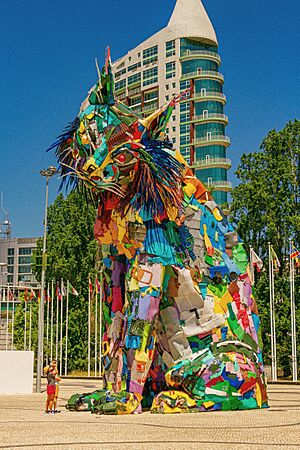
Scientists study the genes of Iberian lynxes. They have found that the lynx has less genetic diversity than other wild cats. This is because their population became very small and isolated.
Lynxes in different areas, like Doñana and Andujar, have some genetic differences. The lynxes in Doñana showed a lot of inbreeding. This happened because they were isolated for a long time. Genetic diversity is important for a species to stay healthy and adapt to changes.
|
See also
 In Spanish: Lince ibérico para niños
In Spanish: Lince ibérico para niños
- Bobcat
- Canada lynx
- Felicola isidoroi



